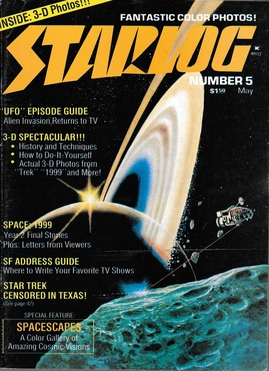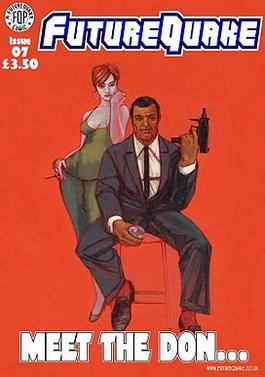Related Research Articles

Forrest James Ackerman was an American magazine editor; science fiction writer and literary agent; a founder of science fiction fandom; a leading expert on science fiction, horror, and fantasy films; a prominent advocate of the Esperanto language; and one of the world's most avid collectors of genre books and film memorabilia. He was based in Los Angeles, California.
Syfy is an American basic cable television channel, which is owned by the NBCUniversal Media Group division and business segment of Comcast's NBCUniversal. Launched on September 24, 1992, the channel broadcasts programming relating to the science fiction, horror, and fantasy genres. As of January 2016, Syfy is available to 92.4 million households in America.

Dreamwatch was a British magazine covering science fiction and fantasy films, books and television programmes.

SFX is a British magazine covering the topics of science fiction and fantasy. Its name is a reference to the abbreviated form of "special effects".
Radell Faraday Nelson was an American science fiction author and cartoonist most famous for his 1963 short story "Eight O'Clock in the Morning", which was later used by John Carpenter as the basis for his 1988 film They Live.

Starlog was a monthly science fiction magazine that was created in 1976 and focused primarily on Star Trek at its inception. Kerry O'Quinn and Norman Jacobs were its creators and it was published by Starlog Group, Inc. in August 1976. Starlog was one of the first publications to report on the development of the first Star Wars movie, and it followed the development of what was to eventually become Star Trek: The Motion Picture (1979).

A science fiction magazine is a publication that offers primarily science fiction, either in a hard-copy periodical format or on the Internet. Science fiction magazines traditionally featured speculative fiction in short story, novelette, novella or novel form, a format that continues into the present day. Many also contain editorials, book reviews or articles, and some also include stories in the fantasy and horror genres.
Locus: The Magazine of The Science Fiction & Fantasy Field, founded in 1968, is an American magazine published monthly in Oakland, California. It is the news organ and trade journal for the English-language science fiction and fantasy fields. It also publishes comprehensive listings of all new books published in the genres. The magazine also presents the annual Locus Awards. Locus Online was launched in April 1997, as a semi-autonomous web version of Locus Magazine.

Science Fiction World, began in 1979, is a monthly science fiction magazine published in the People's Republic of China, headquartered in Chengdu, Sichuan. It dominates the Chinese science fiction magazine market, reaching a peak circulation of 300,000–400,000 copies per issue for a time after 1999, as a result of coincidentally publishing an issue matching the essay topic of the gaokao for that year, memory transplantation, which earned recognition from Xinhua.
David A. McIntee is a British writer.

FutureQuake was a British small press comic book founded by Arthur Wyatt, and later edited by Richmond Clements, David Evans and Owen Watts. Dedicated to showcasing work by new writers and artists, they published mostly self-contained comic stories, generally of 5 pages or less and usually of a sci-fi/fantasy/horror bent.

Mir Fantastiki, officially abbreviated as MirF, is a Russian monthly science fiction and fantasy magazine. The name also refers to the website run by the magazine, Mirf.ru.

Bengali science fiction is a part of Bengali literature containing science fiction elements. It is called Kalpabigyan or stories of imaginative science, in Bengali literature. The term was first coined by Adrish Bardhan during his editorship years.

Mundane science fiction (MSF) is a niche literary movement within science fiction that developed in the early 2000s, with principles codified by the "Mundane Manifesto" in 2004, signed by author Geoff Ryman and "The Clarion West 2004 Class". The movement proposes "mundane science fiction" as its own subgenre of science fiction, typically characterized by its setting on Earth or within the Solar System; a lack of interstellar travel, intergalactic travel or human contact with extraterrestrials; and a believable use of technology and science as it exists at the time the story is written or a plausible extension of existing technology. There is debate over the boundaries of MSF and over which works can be considered canonical. Rudy Rucker has noted MSF's similarities to hard science fiction and Ritch Calvin has pointed out MSF's similarities to cyberpunk. Some commentators have identified science fiction films and television series which embody the MSF ethos of near-future realism.

Matt Bielby is a magazine editor based in the UK. He is best known for launching and editing many successful titles in assorted markets during the 1990s, mostly on the subjects of computer and video games, and film and television. These include .net, Amiga Power, Super Play and PC Gamer.

Blackfish Publishing was a magazine publishing company based in Bath, UK. Its first title was Death Ray, a science fiction and fantasy title.
Flash Gordon is a short-lived science fiction television series that debuted on Sci-Fi in the United States on August 10, 2007 and continued airing new episodes through February 8, 2008. It has also appeared on the British/Ireland variant of Sci-Fi and Space in Canada. The series was developed by Peter Hume, who served as executive producer/show runner and wrote the first and last episodes, among others.
SciFiNow was a British magazine published every four weeks by Kelsey Media in the United Kingdom, covering the science fiction, fantasy and horror genres. It launched in April 2007, with the print publication ceasing in May 2020.

Lou Anders is the author of the Thrones & Bones series of middle grade fantasy novels. Anders is a Hugo Award-winning American editor, a Chesley Award-winning art director, an author and a journalist.
Angry Robot is a British-based publishing house dedicated to producing modern adult science fiction and fantasy, or as they call it “SF, F and WTF?!?”. The Nottingham-based company first released books in the UK in 2009, and since September 2010 has simultaneously been publishing its titles in the US as well, as a distributed client of Random House. All titles are released as paperbacks and eBooks.
References
- 1 2 3 Reynolds, John (14 April 2009). "May launch for new film mag". Media Week. Retrieved 12 January 2012.
- 1 2 3 "New movie mag launched in Bath". Thisisbath. 28 May 2009. Retrieved 12 January 2012.
- ↑ "SFX founder returns to sci-fi". Press Gazette. 27 April 2007. Archived from the original on 5 February 2012. Retrieved 12 January 2012.
- ↑ Issue 6, The New Kids on the Block Archived 2008-10-05 at archive.today , Pages 11-15, Hub Magazine (11 May 2007), Retrieved 6 December 2007
- ↑ "SF Diplomat: REVIEW - Death Ray Magazine (Issue One)". Archived from the original on 2 June 2007. Retrieved 23 May 2007.
- ↑ All change at Blackfish Archived 2009-02-25 at the Wayback Machine , August 18, 2008
- ↑ DeathRay Subscriptions
- ↑ "The death of Death Ray". Archived from the original on 12 October 2009. Retrieved 7 October 2009.